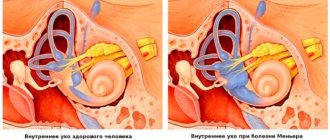In this article we will tell you:
- Symptoms of anisocoria
- Classifications of anisocoria
- Physiological and pathological anisocoria
- Congenital and acquired anisocoria
- Diagnosis and treatment of anisocoria
Anisocoria is present in 20% of the world's population, however, in most cases it is a physiological disease. A person with this diagnosis has pupils of different diameters
. It looks unusual, but physiological anisocoria does not pose a health threat.
It’s another matter when the condition is accompanied by unpleasant symptoms: photophobia, double vision, pain, decreased visual acuity. In this case, consultation with an ophthalmologist and selection of effective therapy is indicated. Pupillary anisocoria may be an important diagnostic criterion indicating ocular or nervous system involvement. The disease can occur at any age, most often in young females. If a child suffers from the pathology, there is a high risk of developing various refractive errors.
About physiological and pathological anisocoria, signs, causes of anisocoria in adults and treatment methods - in our article.
So,
anisocoria
is an ophthalmological symptom in which a person’s pupils are asymmetrical (that is, they have different diameters)
. In this case, one eye functions normally, and the other reacts to light in a pathological way, not expanding or contracting as in a normal, healthy state.
Symptoms of anisocoria
Anisocoria can be asymptomatic, but can bring many unpleasant minutes, causing:
- dizziness, headaches;
- decreased visual acuity, appearance of spots before the eyes, diplopia (double vision);
- nausea leading to vomiting;
- motor dysfunctions: paresis and partial paralysis, hand tremors;
- impaired coordination of movements.
In addition, anisocoria leads to:
- increased eye fatigue, especially during exercise;
- drooping, drooping of the upper eyelid – so-called ptosis;
- corneal edema, pain;
- deterioration of eyeball mobility;
- protrusion of the eyeball forward. This phenomenon is called “proptosis”.
GENERAL INFORMATION
To understand exactly what problems are associated with the development of anisocoria, it is necessary to understand the structure of the pupil and the specifics of its work. The main function of the pupil is to transmit light to the retina and monitor its amount. This is why the pupil has a deep black color in all people, regardless of the color of the iris, skin tone or area of residence. The color allows the pupil to absorb up to 100% of the rays and at the same time control the process.
The pupil determines how many photons hit the retina. This moment is corrected by decreasing or increasing its diameter. So, in bright light, the pupils narrow to somewhat limit the flow of light entering the retina. In dim lighting, the pupil dilates, increasing the flow of photons. Healthy eyes react to changing conditions almost instantly, since the pupils are highly sensitive.
In patients with anisocoria, only one eye responds to changes in light flux. The second, for one reason or another, loses this ability. The pupil may not respond
, both to increase the level of illumination, remaining expanded, and to reduce the intensity of illumination, without increasing in diameter. If the patient does not have injury to the eyeball or iris, then we are talking about parasympathetic innervation, and anisocoria is associated with damage to nerve fibers.
Classifications of anisocoria
There are several classifications of this condition.
Physiological and pathological anisocoria
With physiological anisocoria, the difference in pupil size is observed more often at rest, and the diameter of the affected pupil does not differ from the healthy one by more than 1 mm and does not depend on the level of illumination.
Physiological anisocoria is characterized by the disappearance of symptoms when using special drops that dilate the pupil.
Pathological anisocoria signals a malfunction in the body: ophthalmological or neurological diseases. The pupil can contract and dilate depending on the brightness of the light.
Congenital and acquired anisocoria
Congenital anisocoria is a consequence of genetic diseases, disorders in the embryonic development of the nervous or muscular apparatus of the eyes. Often accompanied by strabismus and may disappear with age. If the condition does not go away, it usually does not affect the quality of vision in adulthood.
Causes of acquired anisocoria:
- neurology;
- disturbances in the functioning of the nervous system;
- migraine (impaired pupil symmetry occurs as a result of swelling of brain tissue);
- vascular diseases of the brain, strokes, cerebral infarctions (in this case, anisocoria is one of the symptoms and is usually accompanied by increased blood pressure, vomiting, nausea, headache, impaired motor function, loss of coordination);
- injuries of the iris, ligaments of the eye apparatus, brain;
- foreign body getting into the eye;
- oncological diseases of the brain;
- eye surgery (for example, cataract removal);
- inflammatory eye lesions (iritis, iridocyclitis);
- brain infections (meningitis, encephalitis, etc. - with these diseases the functionality of the nuclei of the optic nerves suffers);
- taking certain medications;
- drug use;
- tuberculosis of the upper lungs;
- glaucoma;
- paralysis and paresis of the oculomotor nerve of various origins.
In addition, the cause of different pupil sizes in an adult can be:
- Horner's syndrome. This symptom complex is characterized by lesions of the sympathetic nervous system. In addition to ophthalmological ones, it also causes vascular tone disorders and sweating.
- Argyle Robertson syndrome. The cause of the phenomenon in which the pupils stop responding to changes in lighting is often infection of the organ of vision due to neurosyphilis and neuropathy of diabetic origin.
- Holmes-Adie syndrome. With Adi syndrome, abnormal mydriasis (dilation) of the pupil is observed, accompanied by impaired sweating, twitching of the limb, and farsightedness. Occurs due to viral or bacterial inflammation of postganglionic fibers.
- Parinaud's syndrome. The cause of the disease is damage to the posterior parts of the midbrain due to tumors, injuries, and multiple sclerosis.
What happens to the pupils?
As we have already found out, sympathetic nerves are responsible for pupil dilation. They begin in the last cervical and two upper thoracic segments of the spinal cord. Next, their “path” goes through the cervical sympathetic trunk and ends in the superior sympathetic cervical ganglion, which is located at the level of the second and third cervical vertebrae. The nerves of this node penetrate the skull along with the internal carotid artery. The description is quite confusing, but it is important to understand how long and complex the course of the sympathetic nerves is in order to understand the mechanism of the problem. And along this path there are many places where they can be compressed by surrounding tissues.
Most often this occurs at the level of the second and third cervical vertebrae. Usually the nodes are compressed unequally; on one side the node may be more irritated, so in one of the eyes the pupil dilates more.
Five steps from osteochondrosis. Gymnastics for the cervical spine Read more
Such anisocoria is called physiological. In such cases, the normal reaction of the pupils to bright light is preserved, and when drops are instilled, their size is evened out.
But, despite the fact that there are no additional symptoms or disturbances in vision and well-being, different pupil sizes indicate that a person has problems at the level of the cervical spine, which should be dealt with exclusively by an osteopath.
Diagnosis and treatment of anisocoria
An ophthalmologist will be able to make a diagnosis of “anisocoria” based on examination, studying the reaction of the pupils in the dark, in the light, studying the speed of their reaction, and symmetry under different conditions.
In addition, a biomicroscopic examination, diascleral transillumination using a diaphanoscope, and, if necessary, angiography, ultrasound, MRI and CT will be performed. The doctor can also use mydriatics - special drops that can cause artificial dilation of the pupil.
There are also special tests - tropicamide and phenylephrine and pilocarpine - to help make the diagnosis.
Physiological anisocoria, which does not cause any problems to the patient, does not require treatment. Only a cosmetic defect can cause inconvenience.
For anisocoria associated with diseases of the body, treatment consists of eliminating the underlying disease.
Who to turn to for help if your pupils become asymmetrical
If anisocoria is suspected, a first visit to an ophthalmologist should be made. This doctor will confirm or deny the presence of pathology and identify the cause of its occurrence. If it is not related to the organ of vision, the patient will be referred to a neurologist or neurosurgeon.
If necessary, you may need to consult an infectious disease specialist, otolaryngologist, endocrinologist, or surgeon.
Anisocoria is not considered an independent disease and is often a physiological phenomenon that does not require therapy. However, it can be a symptom of other diseases, so if it appears, you should consult a doctor to rule out a condition that requires emergency treatment.
Doctors' forecasts
Prognosis for anisocoria depends only on how quickly the real cause of the disease is identified, and on how quickly and effectively the child receives the necessary treatment.
Congenital pathology is successfully treated surgically.
If the operation is not possible for a number of reasons, the child is prescribed drops in the eyes, which, if taken systematically, will maintain normal vision. For acquired anisocoria, the prognosis is more favorable, while some congenital cases remain with the child for life and cannot be corrected.
To learn how the diagnosis is determined based on the pupil, see the following video.
The human eye is such a unique and necessary “device” that loss of vision is perceived by many as the most terrible tragedy. It is not for nothing that vision is considered the most important of all sense organs. One of the important features of the eye pupil is the change in its diameter depending on the level of illumination. That is, the pupil works like a diaphragm - in bright light it narrows, and when the light level decreases it expands. But there are a number of pathologies in which the diaphragm stops working.
Treatment of trachoma
If trachoma was diagnosed in the initial stages, then drug treatment is prescribed. Usually these are drugs containing sulfonamides and antibiotics. Moreover, the treatment process takes place in a hospital setting. Such measures are explained by the high degree of spreading infection.
Treatment, under the constant supervision of doctors, allows, on the one hand, to reduce the risk of infection in the patient’s environment. On the other hand, it allows doctors to control the source of infection and reduce the likelihood of relapse of the disease. In addition, inpatient treatment avoids the development of complications.
Since trachoma is provoked by chlamydia, which is an intracellular parasitic infection, broad-spectrum antibiotics are used for treatment. Fluoroquinolones, macrolides or tetracyclines have a detrimental effect on the trachoma pathogen.
The disease in the initial stages is eliminated with the help of the drug Albucid or Etazolic and Sulfapyridazine ointments. Additionally, antimicrobial and antibacterial drugs are prescribed - Uniclofen, Tobrex, Chloramphenicol or Erythromycin. To eliminate severe inflammation, Dexamethasone, Hydrocortisone and Prednisolone are used. To significantly speed up the healing of damaged tissue, Dexpanthenol and Diclofenac are prescribed.
In addition, immunomodulators and interferon-based medications are necessarily prescribed. They can significantly increase the body's resistance, reducing the risks of possible complications. The recovery period will vary depending on the stage of the disease. As a rule, recovery takes 4 standard weekly courses, including breaks of 10 days.
Often, after recovery, re-infection occurs. Therefore, to reduce the recurrence of trachoma, the patient is registered. Registration allows you to monitor the patient’s condition and, if necessary, resume treatment. Usually, examinations are prescribed every 3 months. This measure helps reduce the risk of trachoma becoming chronic.
In addition to drug treatment, mechanical methods of removing follicles are also used. In this case, they are squeezed out under anesthesia. The doctor uses tweezers to apply pressure to the inflamed areas, provoking the release of secretions. The wounds formed after the procedure are thoroughly washed, and a medicinal ointment is placed under the eyelids.
This measure can significantly reduce recovery time, eliminate unpleasant symptoms of the disease and provoke rapid scarring of the affected area. However, the procedures for opening the follicles are not a panacea, but only a measure that complements the main treatment. In addition, in some cases, several of these procedures may be required. They are usually carried out at intervals of 1-2 weeks.
If the disease reaches severe stages, surgery may be required. The operation will help eliminate the consequences of trachoma and other diseases that complicate the treatment process. The type of intervention will vary depending on the symptoms experienced. For example, when turning up the eyelids, surgery is performed to eliminate this defect in order to give the ciliary edge the correct location.
Symptoms and signs of the disease
With congenital pathology, which is assessed as normal, anisocoria is usually expressed in the dark. The difference in pupil size does not exceed one millimeter; there is a response to light in the affected eye. The symptom disappears after instilling drops that dilate the pupils.
If the following symptoms occur, you should undergo an examination:
- the abnormal pupil does not respond to light;
- the upper eyelid is drooping or, conversely, raised;
- impaired vision;
- headache, nausea, photophobia appears;
- double vision;
- delayed response to light stimulation;
- the appearance of pain and swelling of the cornea;
- slow dilation of the abnormal pupil when looking into the distance.
Important! If the eye is mechanically damaged, the pupil is dilated and will not respond to light or instillation of medical drops
Features of anisocoria in children
The disease is detected in children from birth. Anisocoria may indicate heredity or a pathological condition. This can be determined by conducting a thorough diagnosis.
If the pupil suddenly becomes larger, this may indicate a bruise, a tumor process, encephalitis or an aneurysm. In older age, the cause may be meningitis, trauma, inflammation, poisoning or Eydie syndrome.
In children, anisocoria is manifested by drooping of the upper eyelid of the affected eye, vomiting, cephalgia and increased body temperature. Symptoms appear with varying intensity. Kids become irritable and whiny.
Diagnosis in children is carried out in the same way as in adults. The cause of the asymmetry is identified, then a treatment regimen is determined.
For inflammatory conditions, local and systemic antibiotics are prescribed; for meningitis and encephalitis, complex treatment is prescribed.
Pathologies that cause changes in pupil size
Often anisocoria becomes a symptom of another disease. The following pathologies provoke asymmetry:
- Glaucoma is manifested by a narrowing of the field of vision, rings and circles before the eyes, and acute pain. When looking at a light source, nausea and vomiting occur. Intraocular pressure increases.
- Uveitis is characterized by fog and blurred vision and rapid fatigue. The pathology leads to decreased visual acuity, headache, hyperemia, increased sensitivity to light and photophobia.
- Tumor in the eyes accounts for 2–4.3% of all cases. It can be malignant or benign. The tumor puts pressure on the nerve pathways and visual centers, hence the fixed position of one pupil.
- Convulsive syndrome is a common manifestation of central nervous system damage. This is an involuntary contraction of muscle fibers. After injuries, convulsions are clonic-tonic in nature. Different pupil sizes and nystagmus appear.
- Syphilis affects the organs of vision. This occurs at different periods of acquired or congenital disease. Syphilis develops in the optical system due to treponemes entering the eye tissue. It is often associated with visual dysfunctions, including anisocoria and Ardgyle Robertson syndrome.
The cause of the development of asymmetry can be an aneurysm, Parinaud's syndrome, carotid artery thrombosis and many other pathological conditions affecting the optical system.
Prevention
Prevention of anisocoria is not always possible. However, some measures can reduce the risks of its occurrence (including recurrence):
- Maintaining the general condition of the body, immunity;
- Timely treatment and relief of diseases;
- Avoiding situations that pose a risk of injury;
- Maintaining a diet and maintaining a healthy lifestyle;
- Undergoing preventive examinations with an ophthalmologist (at least once a year);
- If discomfort and the first symptoms of visual impairment occur, seek medical help promptly.
Prevention of anisocoria includes:
- Timely visit to a neurologist or ophthalmologist when the first symptoms of anisocoria appear.
- Cholesterol level control and correction.
- Blood pressure control.
- Controlling blood sugar levels.
Among preventive actions, the most important thing is to sound the alarm in time and find out the cause of the deviation. If the problem is solvable and does not pose a threat to the health and life of the patient, recommendations will be limited to advice on maintaining a healthy lifestyle. But, in any case, it is necessary to strictly follow the instructions of the attending physician and adhere to the prescribed therapy. Only with complete mutual understanding between the doctor and the patient can a positive result be achieved and quickly get back on your feet.









